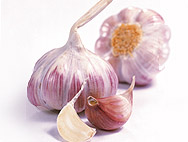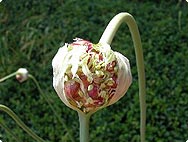
Allium sativum L.
Garlic

History
Garlic is an ancient cultivated plant whose origins lie in the Central Asian Steppes. It was a valuable remedy in ancient Indian medicine. Garlic and the common onion (Allium cepa) found their way from the Far East to Egypt, where the Egyptians systematically cultivated both plants. This cultivation took away much of the plant's pungency and garlic soon became a regular ingredient in the Egyptian diet. The Pyramid of Cheops would not have been built were it not for radishes, onions and garlic. With the aid of these plants, the vast armies of people needed to build these structures were protected from emaciation and infectious diseases. Priests, however, were not allowed to consume garlic, since the plant was considered to be holy, a gift of the gods and an aphrodisiac. The warming, pungent cloves were soon to be found in the west and north. They were also used by the Greeks, Romans and Teutons as an ingredient in dishes, a seasoning and a herbal remedy. Garlic was described by Hippocrates and Dioscorides and is mentioned in herbal books from the Middle Ages. The Nordic saga of the gods, the Edda, describes Garlic as a means of warding off evil spirits. Garlic used to be applied in the treatment of conditions other than those it is normally used to treat today. Lonicerus wrote that Garlic was the rustics' Theriac or panacea. He recommended its use in the treatment of ’swellings in the body‘ since it softens and opens the abscess and draws out the pus. Skin infections, inflammations, worms, kidney insufficiency, bronchial catarrh and stomach ache were the typical conditions to be treated by garlic. According to Lonicerus, one should always use the clove in propagation otherwise the plant would become poisonous in the sixth year. The ancient Greeks and Romans called Garlic scorodon. The etymology of the name Allium is uncertain. The word has been associated with the Latin word, olere meaning ’to smell‘ as well as the Greek term hallesthai, meaning ‘to jump out’. This refers to the plant's rapid growth. The word sativum bears some relation to the term ’to sow‘. The word garlic is of Anglo-Saxon origin, being derived from gar, a ’spear‘, and lac, ’a plant‘ in reference to the shape of its leaves. In spite of its pungent smell, Garlic has a firm place in the diet of many different cultures. According to Alfred Vogel, its smell can be avoided by eating some fresh raw parsley at the same time as consuming Garlic. It is, however, in our own interests to be somewhat more tolerant towards Garlic's odour since its wide spectrum of efficacy has been well documented in innumerable studies and publications.

Botanical characteristics
Garlic is a perennial plant that grows from a bulb. The elongated main bulb of the plant is situated at the base of the plant and sits on top of a hard, flat ring the underside of which is covered in roots. Around the main bulb are the closely-packed, curved bulblets or cloves. Each clove is enclosed by a white membranous skin, and together they form the garlic bulb which is about as large as a fist. The 30cm to 80cm high leafless flower stalk rises directly from the bulb. At its base this stalk is enclosed by tubular leafy sheaths. It usually bears five lineal, leek-green coloured leaves and at the tip of the stalk is the umbel, which is enclosed on one side by a very long, pointed white spathe. The whitish flowers which are mostly sterile have more than six angular petals. In between the flowers are tiny, rotund, egg-shaped bulbils which form new plants when they drop to the ground. The plant flowers from July to August.
Habitat
Allium sativum is cultivated all over the world in warm temperate climes and is used largely as a herb and a vegetable.
Preparation
A.Vogel/Bioforce uses an oil macerate made from fresh garlic cloves and rape oil. The two ingredients are made into soft gelatine capsules.
A.Vogel Blog – Natural and Healthy
Inspiration for a healthy life!
HERBAMARE SOUP-ER SOUPS!
DOWNLOAD YOUR FREE RECIPE BOOKLET!
8 healthy, hearty and delicious homemade soups.
Supporting a healthier happier you
“Nature is just about the best thing we’ve got!“
Alfred Vogel's guide to leading a healthy and happy life
Healthy & nutritious dinner ideas
Get new recipes in your inbox every month. Sign up now